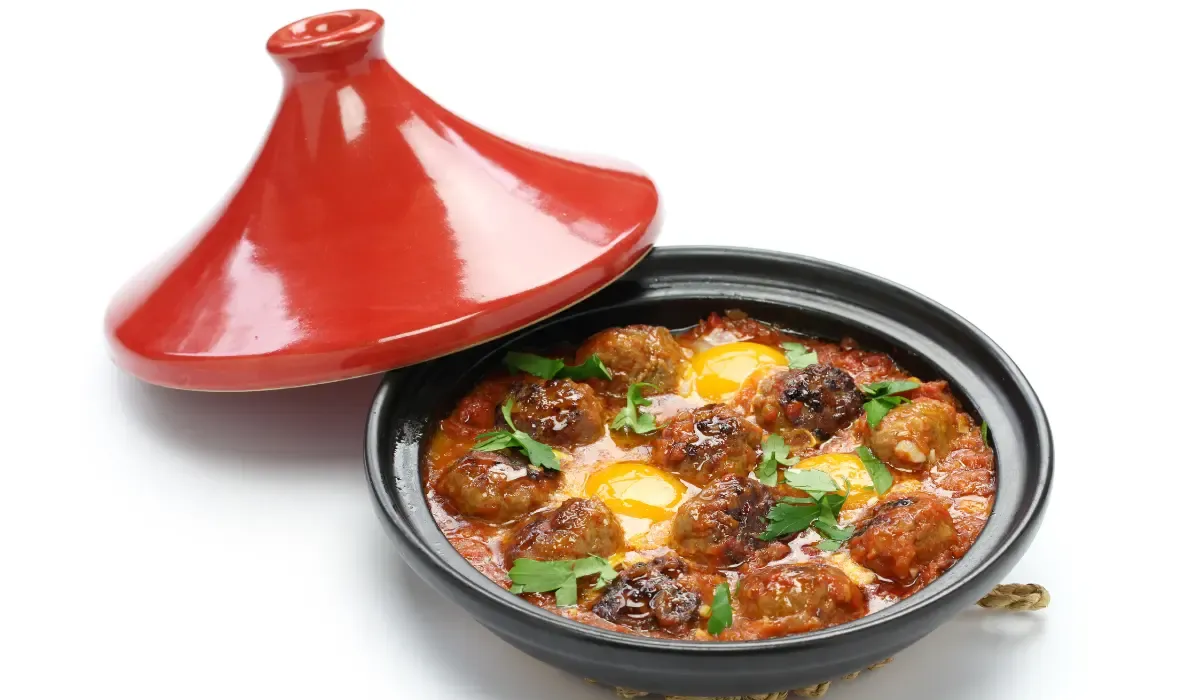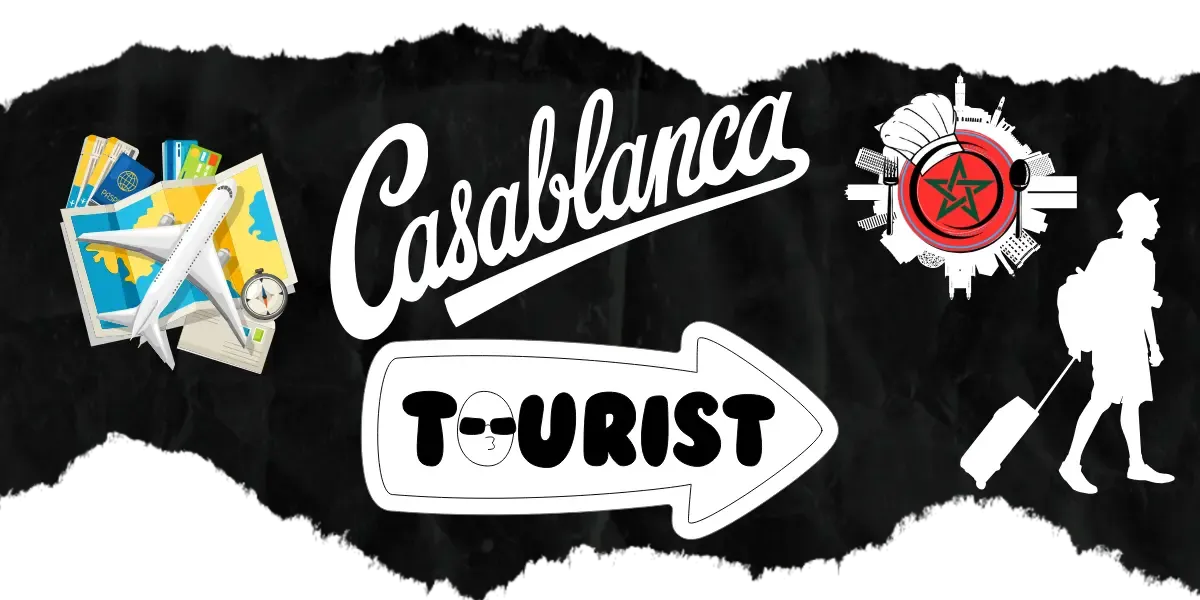Casablanca: Culinary & Cultural Journey
Discover the flavors and heritage of Morocco's largest city.
Gastronomic Delights

Must-Try Specialties
- Seafood Pastilla - Flaky pastry with spiced fish
- Harira - Traditional soup with lentils and chickpeas
- M'semen - Square-shaped semolina pancakes
- R'ziza - Casablanca-style vermicelli with milk
- Maakouda - Potato fritters street food
- Sellou - Sweet energy dessert with sesame
Cultural Treasures of Casablanca

Heritage & Cultural Sites
Discover Casablanca's rich history through its remarkable landmarks...
Top Attractions
- Hassan II Mosque - Islamic architectural masterpiece
- Habous Quarter - The historic heart of the city
- Ain Diab Corniche - Scenic oceanfront promenade
- United Nations Square - Vibrant city center
- Old Medina - Traditional walled city
- Rick's Café - Famous homage to the classic film
- Arab League Park - Lush urban oasis
City Map
Casablanca is Morocco's largest city and economic capital, located on the Atlantic coast about 80 km south of Rabat. While not one of Morocco's imperial cities, it serves as the country's commercial and industrial hub. Casablanca's modern history began in the 18th century when it was rebuilt by Sultan Mohammed ben Abdallah, though the area had been settled since Phoenician times.
Modern Metropolis

Urban Innovation & Infrastructure
Casablanca stands as Morocco's most modern city, boasting impressive infrastructure and a dynamic business environment. The city features contemporary landmarks like the Casablanca Finance City tower, the Morocco Mall (Africa's largest shopping center), and the sprawling Anfa Place business district. As the economic capital, it offers world-class museums including the Villa des Arts contemporary art space and the Abderrahman Slaoui heritage museum. The city blends modernity with tradition through its Art Deco architecture, thriving nightlife, and cosmopolitan dining scene.
Luxury Kitchens in Casablanca

High-End Kitchen Designs
Casablanca's luxury kitchens showcase a sophisticated fusion of international trends and Moroccan craftsmanship. Signature elements include:
- Minimalist European designs with artisanal Moroccan details
- Custom Italian cabinetry paired with handcrafted tadelakt finishes
- Smart kitchen technology integrated with traditional cooking spaces
- Premium materials like marble countertops with geometric Arabesque inlays
- Professional-grade appliances tailored for both Moroccan and international cuisine
As Morocco's economic hub, Casablanca boasts world-class kitchen design studios and master craftsmen who create bespoke kitchens for luxury residences and upscale restaurants throughout the city.
Casablanca's Signature Dishes
Experience the cosmopolitan flavors of Casablanca through its most celebrated culinary creations

Grilled Sardines
Fresh Atlantic sardines marinated in chermoula and grilled to perfection, a staple of Casablanca's coastal cuisine.
View Recipes →
Seafood Pastilla
Casablanca's coastal twist on the classic pastilla, filled with shrimp, calamari and fish in a delicate warqa pastry.
View Recipes →
Rfissa
Rfissa is a cherished dish in Casablanca, known for its rich flavors and cultural significance. Traditionally prepared for new mothers, this hearty meal combines chicken, lentils, and msemen (thin crepe-like bread) with a fragrant broth seasoned with fenugreek, saffron, and Ras el Hanout. The dish is believed to help replenish nutrients and support recovery after childbirth.
View Recipes →
Modern Tagine
Chef-inspired interpretations of the classic tagine featuring innovative ingredient combinations and presentations.
View Recipes →
Maakouda
Golden potato fritters served in crusty bread with harissa, a beloved Casablanca street food snack.
View Recipe →
Ain Diab Grilled Seafood
Fresh catches grilled seaside along the Corniche, served with lemon and spicy sauces at Ain Diab's famous seafood stalls.
View Recipe →
Casablanca is the largest city in Morocco and the economic capital of the country. It is also one of the largest and most important cities in Africa, both economically and demographically.
The city is located on the Atlantic coast of Morocco, and is home to a diverse population of over 3.5 million people.
Casablanca has a diverse culinary scene, reflecting the city's multicultural population. Some of the most popular dishes in Casablanca include tagines, couscous, and pastilla. Is a vibrant city with a rich culture and history. Its cuisine is no exception, reflecting the city's multicultural population.
Casablanca is a great place to experience Moroccan cuisine. The city is home to a variety of restaurants that serve traditional Moroccan dishes, as well as more modern eateries that offer a fusion of Moroccan and international flavors

The pleasure of walking the streets of any city in the world is not complete without eating. The pleasure is even greater if the food is light and cheap, and it can be eaten while walking away from the formal atmosphere of restaurants.
In the streets and markets of the Moroccan capital, as is the case in many cities around the world that see a lot of movement, carts spread that provide light and different meals at simple prices ranging from a quarter of a dollar to one dollar at most.
Light, quick to prepare, and cheap, these are the three basic qualities that are available in "street food", which is popular with many people, including even tourists, who seek to discover those simple popular dishes.
Casablanca's Famous Street Food
Discover the Vibrant Street Food Culture of Casablanca

Grilled Sardines
A Casablanca coastal specialty, fresh sardines are marinated in chermoula (a mix of herbs and spices) and grilled to perfection. Often served with bread and lemon, this dish showcases the city's connection to the Atlantic Ocean and is a must-try at the portside stalls.
View Recipes →
Bessara
A hearty fava bean soup that's a breakfast staple in Casablanca. Served hot with a drizzle of olive oil, cumin, and sometimes spicy harissa, this nutritious dish fuels locals and visitors alike. You'll find it at small street-side stands throughout the city, especially in the early morning hours.
View Recipes →
Brochettes
Skewered and grilled meat (usually lamb or beef) that's ubiquitous in Casablanca's street food scene. The meat is marinated in spices and grilled over charcoal, served with bread and often accompanied by grilled peppers and tomatoes. The best brochettes can be found in the bustling alleys near the Central Market.
View Recipe →
Msemen
A flaky, layered Moroccan pancake that's a popular street food in Casablanca. It can be served plain, with honey or jam for breakfast, or stuffed with meat or cheese as a savory snack. The dough is folded multiple times with butter or oil between layers, then cooked on a griddle until crispy.
View Recipe →
Harira
Casablanca's version of this traditional Moroccan soup is particularly rich and flavorful. Made with tomatoes, lentils, chickpeas, lamb, and a blend of spices, it's especially popular during Ramadan when it's served to break the fast, but available year-round from street vendors and small restaurants.
View Recipes →
Fresh Seafood
Casablanca's coastal location means incredibly fresh seafood is available daily. At the port and seafood markets, you can choose your fish, shrimp, or other seafood and have it grilled on the spot with simple seasonings. The oysters from nearby Oualidia are particularly prized and often served raw with lemon.
View Recipe →
Mint Tea & Sweets
No visit to Casablanca is complete without experiencing the ritual of Moroccan mint tea. Street vendors and small cafes serve this sweet, aromatic tea alongside an array of traditional pastries like chebakia (sesame cookies), briouats (stuffed pastries), and various almond-based sweets - perfect for an afternoon break while exploring the city.
View Recipes →SOME TIPS FOR EXPERIENCING MOROCCAN KITCHEN IN CASABLANCA:
- Visit a traditional Moroccan restaurant in Casablanca and order a tagine. This is a must-try dish that is sure to please.
- Try some of the local street food. Casablanca offers many delicious options, such as msemen, pastilla, and harira, or seafood specialties like grilled sardines at the port.
- Take a cooking class. This is a great way to learn about Moroccan cuisine and how to make some of your favorite dishes at home.
TOURISM IN CASABLANCA

Things to Do in Casablanca
Discover Morocco's economic capital and its vibrant attractions

Hassan II Mosque
The largest mosque in Africa and the 7th largest in the world, featuring a stunning 210-meter minaret and a glass floor section overlooking the Atlantic Ocean.
Know more +
La Corniche
Casablanca's vibrant beachfront district with upscale restaurants, nightclubs, and public beaches, perfect for sunset views and seaside relaxation.
Know more +
Old Medina
The historic heart of Casablanca with narrow alleyways, traditional markets, and authentic Moroccan craftsmanship dating back to the 18th century.
Know more +
Royal Palace of Casablanca
The official residence of the King of Morocco in Casablanca, featuring magnificent traditional Moroccan architecture and beautiful gardens.
Know more +
Habous Quarter
A charming neighborhood blending French colonial and traditional Moroccan architecture, known for its artisanal shops and the King's Mosque.
Know more +GEOGRAPHY & LOCATION
Casablanca is Morocco's largest city, located on the Atlantic coast in the central-western part of the country. It serves as the country's economic and business capital.
- Coordinates: 33°32′N 7°35′W
- Area: 220 km² (85 sq mi)
- Elevation: 0-150 m (0-492 ft)
DEMOGRAPHICS
Casablanca is Morocco's most populous city and one of the largest financial centers in Africa.
- City population: 3.7 million
- Metro population: 6.9 million
- Population density: 14,000/km²
- Growth rate: 2.1% annually
CLIMATE & WEATHER
Casablanca has a Mediterranean climate with oceanic influences:
- Summer (Jun-Sep): 19-26°C (66-79°F), humid
- Winter (Dec-Feb): 8-17°C (46-63°F), mild
- Annual rainfall: 427 mm (17 in)
- Ocean temperature: 17-22°C (63-72°F)
CULTURE & LANGUAGES
Casablanca is Morocco's most cosmopolitan city, blending traditional and modern influences.
- Primary language: Moroccan Arabic (Darija)
- Business language: French widely used
- Religions: Predominantly Muslim (95%)
- Cultural mix: Arab, Berber, French, Spanish influences
ECONOMY & CURRENCY
Casablanca is the economic engine of Morocco, contributing significantly to national GDP.
- Currency: Moroccan Dirham (MAD)
- Financial hub: Home to Casablanca Stock Exchange
- Key sectors: Finance, industry, trade, services
- GDP contribution: ~20% of national GDP
TRANSPORTATION
Casablanca has an extensive transportation network:
- Mohammed V Airport (CMN): 30km from city center
- Casa-Port Train Station: High-speed rail connections
- Tramway: 2 lines covering 47km with 71 stations
- Public buses: Extensive network throughout the city
- Grand taxis: Shared intercity taxis
Key Highlights of Casablanca:
Economic capital of Morocco with modern skyscrapers and business districts
Beautiful Atlantic coastline with the famous Ain Diab beachfront
Home to the magnificent Hassan II Mosque, an architectural masterpiece
Vibrant shopping scene from traditional souks to modern malls
Key Information
Casablanca is Morocco's largest city and main economic center, located on the Atlantic coast. With a population of over 3.7 million, it's the country's business and financial capital.
- Population: ~3.7 million
- Area: 220 km²
- Time Zone: GMT+1
- Currency: Moroccan Dirham (MAD)
Main Attractions
Casablanca blends modern architecture with traditional Moroccan culture, offering visitors a unique urban experience.
- Hassan II Mosque - One of the largest mosques in the world
- Corniche - Vibrant beachfront district
- Old Medina - Traditional market area
- Royal Palace of Casablanca
- Mohammed V Square - Central city square
Transportation
Casablanca has a well-developed transportation network that serves both residents and visitors efficiently.
- Mohammed V International Airport (CMN)
- Tramway system with two lines
- Extensive bus network
- ONCF train connections to other cities
- Petit and Grand taxis available throughout the city
Why Visit Casablanca?
Modern business district with impressive architecture
Vibrant culinary scene blending Moroccan and international flavors
Excellent shopping from traditional souks to modern malls
Rich cultural heritage with French colonial influences
Legendary café culture and nightlife
Gateway to explore other Moroccan cities











%20(1).webp)
.webp)


.webp)

